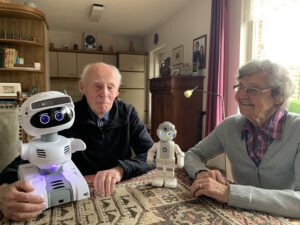How to ensure that the capabilities of a care robot match the needs of older people living at home? With this in mind, ConnectedCare conducted field research by interviewing informal carers, older people and professionals. ‘It is important that Guardian is an extension of guidance, not a replacement.’
As Vilans, we work with national and European partners on the Guardian project. The aim is to develop an advanced robot that supports older people, district nurses and informal carers so that older people can live safely at home for longer with enough comfort. ConnectedCare plays an important role in the co-creation process. ‘We are experienced in developing opportunities for technology in consultation with the end user,’ says Martijn Vastenburg, director and founder. ‘We are therefore focusing on social robots in more and more projects. Guardian has many possibilities. This is because the robot is physically present and the interaction with the social robot is natural in speech and expressions. We want older people to experience Guardian as a pleasant companion who helps with daily life.’
The aim of GUARDIAN is to develop an advanced robot that supports older people living at home, community nurses and informal carers. Want to learn more about Guardian? Read the article: ‘Eyes and ears of Guardian care robot’ (https://guardian-aal.eu/eyes-and-ears-of-guardian-care-robot/) or the article: ‘Guardian: Enhancing the autonomy of older people – respecting privacy’ (https://guardian-aal.eu/eyes-and-ears-of-guardian-care-robot/).

‘You have to be aware of the entire care process’
Caregivers and care professionals will also be using Guardian. That is why their wishes must also be taken into account. Vastenburg: ‘In regard to caregivers, for example, it is important that you don’t come up with a separate solution, but something that can be integrated into the entire care process. It is necessary to avoid that caregivers have to deal with multiple apps and robots, which will make the entire care process, as a set of tasks, more complicated in the future.’
‘Guardian is not a replacement, but an extension’
Researcher and designer Janna Alberts acts as a bridge to all parties at ConnectedCare. ‘Together with colleagues, I am investigating the challenges and opportunities in the design.’ It is especially interesting how older people experience the robot. ‘The interviews taught us that there are people for whom a social robot simply does not fit. But there are also people who find it pleasant and helpful, especially if the robot fulfils a coaching role. It would be great if Guardian could help people to achieve their goals by monitoring and sending reminders and motivational messages. People should not experience the care robot as a replacement for guidance, but as an extension of it.’
Respecting ethical boundaries
Vastenburg: ‘With Guardian we are able to give people the amount of personal attention that you cannot give with human care. Ideally, Guardian will soon ensure that care professionals can focus more on the content of care because a robot takes over some of the automatable tasks. Unlike a care professional, a care robot can provide a complete overview of the collected data because the robot is always in the proximity of an older person. We do, however, keep a close eye on ethical boundaries. The agreement of the older person is always necessary.’
Information exchange between professionals and informal carers
Alberts: ‘In the future, fewer and fewer care givers will be available per client. As a result, the importance of cooperation between different professionals and informal carers will become more important. Guardian provides complete information so that the involved persons can better respond to the needs of older people living at home. One of the possibilities is that the robot will have a chat function. In this way, everyone can quickly interact with each other. Such a chat function must, of course, also fit well into the entire care process. We have to avoid that care professionals perceive chatting as an extra burden. For example, because an informal carer expects a care professional to respond immediately to a chat.’
About Guardian
It is also important that the interaction runs smoothly. Alberts: ‘You really want to make people feel as if they are talking to a person. If the robot says three times: “What are you saying, I don’t understand you!” it could lead to a lot of frustration and the older person could turn the robot off. People should really experience the robot as friendly. That is why we are now starting with a tablet as a linking device. It’s not the end result, but taking too big a step at the beginning can lead to a system that falters down the road. We first want to work out all basic functionalities properly.’



